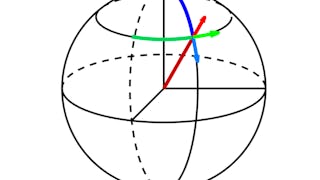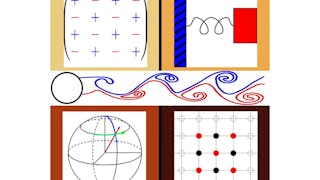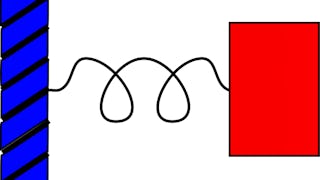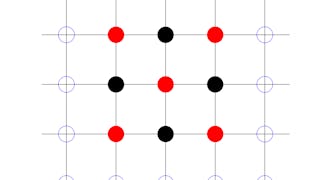This course offers a streamlined approach to university-level calculus, tailored for engineers and scientists. We begin with a review of precalculus in the first module, followed by derivatives and integrals in the second and third modules. The fourth module introduces Taylor series, while the fifth and sixth modules cover important applications of calculus.
通过 Coursera Plus 解锁访问 10,000 多门课程。开始 7 天免费试用。


您将学到什么
Differentiation and integration
Infinite series and Taylor polynomials
Complex exponential function and trigonometric identities
Areas and volumes, minimax problems, velocity and acceleration, numerical methods, and differential equations
您将获得的技能
- Differential Equations
- Graphing
- Advanced Mathematics
- Physics
- General Mathematics
- Applied Mathematics
- Arithmetic
- Calculus
- Numerical Analysis
- Mathematical Modeling
- Geometry
- Integral Calculus
- Engineering Analysis
- Algebra
- Deductive Reasoning
- Trigonometry
- Derivatives
- Mathematical Theory & Analysis
- Engineering Calculations
要了解的详细信息

添加到您的领英档案
26 项作业
了解顶级公司的员工如何掌握热门技能

该课程共有6个模块
Functions lie at the foundations of calculus. First, we revisit the set of real numbers and then introduce complex numbers. We define functions and their inverses, as well as discuss the concepts of limits and continuity. Finally, we introduce the essential functions studied in calculus, including polynomial and rational functions, exponential functions, logarithmic functions, trigonometric functions, and inverse trigonometric functions.
涵盖的内容
11个视频25篇阅读材料5个作业
In this module, we define the derivative and explore methods to differentiate various functions. We begin by learning the power rule to differentiate power functions, followed by learning the sum, product, quotient, and chain rules. We then learn how to differentiate exponential functions, natural logarithms, trigonometric functions, and finally, inverse trigonometric functions.
涵盖的内容
13个视频30篇阅读材料5个作业
In this module, we define the integral and explore methods to integrate various functions. We begin by learning how the definite integral is used to calculate areas. We then find a connection between integration and differentiation by proving the first and second fundamental theorems of calculus. These theorems motivate us to define an indefinite integral as an anti-derivative. Throughout the module, we will examine various integration techniques, including integration by substitution, integration by parts, integration of trigonometric functions, trigonometric substitution, and integration by partial fractions.
涵盖的内容
10个视频16篇阅读材料4个作业
In this module, we explore sequences and series. We learn how an infinite power series can converge to a function. These convergent series are known as Taylor series, and we will determine the Taylor series for the most important functions of calculus, including the exponential function, sine and cosine functions, the natural logarithm, and the arctangent. We also learn L’Hospital’s rule, a very useful tool for finding indeterminate limits.
涵盖的内容
11个视频24篇阅读材料4个作业
In this module, we begin to apply the calculus. Using Taylor series, we define the complex exponential function and use it to prove key trigonometric identities. We employ calculus to derive the circumference and area of a circle, as well as the surface area and volume of a sphere. Finally, we show how calculus can be used in numerical methods to find the roots of equations and to integrate and differentiate functions.
涵盖的内容
11个视频18篇阅读材料4个作业
In this module, we continue exploring applications of calculus. We learn how to use derivatives to find local extrema of functions. We prove that among rectangles with a given perimeter, the one that maximizes the area is a square. We find the shortest path between two villages after collecting water from a river. We determine the optimal position on a beach for a lifeguard to enter the sea to rescue a swimmer in distress. We discuss how calculus is used in physics to define velocity and acceleration, and how to determine the position and velocity of an object falling under gravity. Lastly, we explore differential equations related to growth, decay, and oscillation, including equations for compound interest and the oscillating pendulum.
涵盖的内容
11个视频14篇阅读材料4个作业
位教师

从 Math and Logic 浏览更多内容
 状态:免费试用
状态:免费试用The Hong Kong University of Science and Technology
 状态:免费试用
状态:免费试用The Hong Kong University of Science and Technology
 状态:免费试用
状态:免费试用The Hong Kong University of Science and Technology
 状态:免费试用
状态:免费试用The Hong Kong University of Science and Technology
人们为什么选择 Coursera 来帮助自己实现职业发展




常见问题
Yes, you can. Though you can still take the end of module assessments, they cannot be submitted for a grade, and you will not be eligible to receive a course certificate. If your university has Coursera for Campus, or you have Coursera Plus, or you pay a small course fee, you can submit the module assessments for a grade and receive a course certificate upon successful completion of the course.
To access the course materials, assignments and to earn a Certificate, you will need to purchase the Certificate experience when you enroll in a course. You can try a Free Trial instead, or apply for Financial Aid. The course may offer 'Full Course, No Certificate' instead. This option lets you see all course materials, submit required assessments, and get a final grade. This also means that you will not be able to purchase a Certificate experience.
When you purchase a Certificate you get access to all course materials, including graded assignments. Upon completing the course, your electronic Certificate will be added to your Accomplishments page - from there, you can print your Certificate or add it to your LinkedIn profile.
更多问题
提供助学金,



